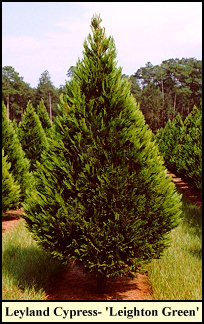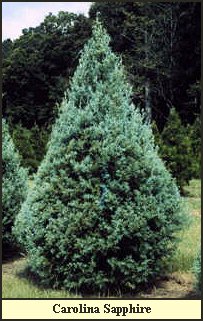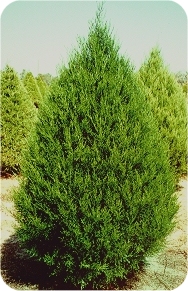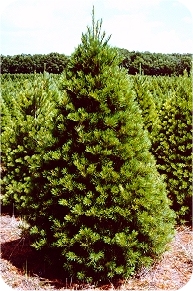Southern Christmas Tree Varieties
Leyland Cypress
x Cupressocyparis leylandii
One of the most popular trees grown in the south. This tree is a hybrid of Monterey cypress and Alaskan cedar. Six seedlings were discovered in 1888 by C.J. Leyland at Leighton Hall in the South of Wales. The two parent trees were growing on the Leighton Hall Estate and cross bred purely by accident. Leyland cypress is a sterile hybrid and must be propagated by individual cutting.
The foliage of the Leyland cypress varies somewhat from one cultivar to the next. But in general it tends to be arranged in irregularly flat planes with a dark green to gray color. The shoots branch repeatedly and have a contrasting mahogany color except at the tips. The trees have little aroma.
The bark of the Leyland cypress is characterized by a skin-like texture. It is quite delicate. Care should be exercised to ensure that it does not tear while being cut.
Arizona Cypress
Cupressus arizonica Greene
The Arizona cypress is a steeple shaped tree with a pale-green to gray-green color. The leaves are extremely tiny and quite plentiful. They lay close to the branchlet surface in a scale like arrangement and are about 0.1 inches long.
The bark is thin and delicate with a reddish brown color. It splits into strips along the length of the tree.
The cones are spherical in shape and woody. They mature in two years. Tiny yellow flowers are visible in the fall of the year. Heights of 80 feet and trunk diameters up to 3 feet have been recorded. The Arizona cypress has a pleasing aroma that some describe as a cross between lemon and mint.
Virginia Pine
Pinus virginiana
Virginia pine has been the staple for the Christmas tree industry in the south since its inception. The branches are stout and woody. The bark is typical for most pines.
The Virginia pine's needles occur in pairs. They are twisted and range from 1.5 to 3" in length. They are relatively short when compared to those of other pines.
Eastern White Pine
Pinus strobus L.
White pine is considered to be the largest pine in the United States. Leaves (needles) are soft, flexible and bluish-green to silver green in color and are regularly arranged in bundles of five. Needles are 2 1/2-5 inches long and are usually shed at the end of the second growing season. Needle retention is good to excellent. White pine has very little aroma, but, conversely, is reported to result in fewer allergic reactions than do some of the more aromatic species.
Bark on young trunks and branches is smooth and tends to be greenish-brown in color. On older trunks, the bark becomes dark gray and shallowly fissured.
Eastern Redcedar
Juniperus virginiana L.
The branches of the eastern redcedar are compact and form a pyramidal crown, except in older trees. The leaves are usually arranged in opposing pairs along the branchlets. They are a dark shiny green color. The bark is reddish brown with a tendency to peel in long fibrous strips.
This tree has a wonderful aroma, but the foliage tends to stick its handler. Gloves are recommended for handling.
The Southern Christmas Tree Association
Photographs and details provided courtesy of the National Christmas Tree Association and Clarke Gernon of
Shady Pond Tree Farm in Pearl River, Louisiana




